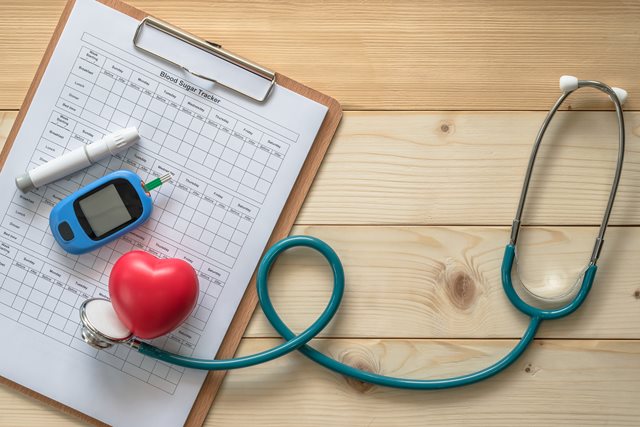Healthy eating can seem complicated, especially when you take into account nutrients (such as carbohydrates, protein, and fat) as well as assorted vitamins and minerals. Add diabetes to the mix and things can seem even more confusing. But take heart, there is a way to make healthy eating simpler: carbohydrate, or carb, counting.
What are carbs, and why do I need to count them?
Carbs are necessary for providing fuel, but they can also have a major impact on your blood glucose (sugar). That is why counting how many carbs you are planning to eat can help keep your blood sugar at healthy levels. You will find carbs in a range of different foods including starchy foods such as grains (think breads and cereals), legumes (think chickpeas), and some vegetables (think potatoes and corn), as well as fruits, and dairy products such as milk and yogurt. You will also find them in foods to which sugar has been added, including baked goods (cake and cookies), sugary beverages, and candy.
Choosing healthy carbs can provide other beneficial nutrients. For example, whole-grain bread or cereal can supply you with fibre, as well as vitamins and minerals. But, as carbs break down into glucose, even having too many healthy ones can lead to high blood sugar or weight gain.
To make high-carbohydrate choices seem less skimpy, you can include lots of low-carb vegetables in the mix. For example, a cup of peppers, onions, and mushrooms added to a cup of pasta makes for a more generous-looking portion that will also make you feel fuller without adding much to your carb totals.
Jennifer Buccino, people affected by diabetes (PAD) knowledge & connection executive director at Diabetes Canada, says,
Counting carbs is a good solution for many people with diabetes because it can be simpler than using a more traditional exchange meal plan [where specific portions of each food group are pre-set] and makes it easier to include a wider variety of foods in a meal plan.
So, how exactly do you count carbs? There are two different ways you could do it: basic and advanced carb counting.
What kind of carb counter should you be?
Basic: Do you manage your diabetes through diet or oral medication, or certain types of insulin (such as long- or intermediate-acting types), rather than mealtime insulin? If so, the basic method is likely best for you. It involves setting a specific amount of carbs for various meals and snacks and keeping that amount consistent. For example, if your goal is 45 grams at lunch, your carbs might come from the two slices of bread (15 grams each, for a total of 30 grams) in your sandwich and a medium-size apple (15 grams) for dessert. But if you decide to have a cup of milk at lunch (12 grams), you might choose an open-face sandwich in order to stay within your goal.
“Breads and cereals can vary a lot in their carbohydrate content, so check the Nutrition Facts on the label to be sure about what you’re eating,” says Buccino, who is also a registered dietitian.
Advanced: Do you take insulin at mealtimes? The advanced method is likely your best choice. This involves matching your dose of insulin to the amount of carbs in a meal or snack. This method gives you more flexibility with your food choices. If you have fewer carbs at a meal, you can take a lower dose of insulin. If you have more carbs, you can take a higher dose.
A registered dietitian (who may also be a certified diabetes educator) can help you determine the number of carbs you should include at meals and snacks. But if your blood sugar readings are not on target, you can increase or reduce the number of carbs as needed.
Whether you use the basic or advanced method for counting carbs, it is important to keep healthy eating goals in mind. It is not enough to concentrate solely on the number of carbs you eat. For instance, eating foods with lots of added sugar will not provide the health benefits of those foods that supply both healthy carbs and disease-fighting nutrients. Plus, added-sugar foods, especially beverages, are less filling and may makemanaging your blood sugars more challenging.
Recipes
Here are three tasty recipes that show how you can stay within your carb limits without feeling deprived.
Vegetable Soup with a Basil and Garlic Garnish
This soup provides the same flavours as a traditional minestrone soup, but it is low in carbs, making it great for meals where your carbohydrate totals are being met by other dishes. Any soup containing beans offers more fibre and protein.
1 tbsp (15 mL) extra virgin olive oil
2 cups (500 mL) chopped onions
4-5 cloves garlic, finely chopped
1½ cups (375 mL) diced carrots
2 stalks celery, diced
2 medium or 3 small zucchini, diced
8 cups (2 L) no-added-salt or sodium-reduced vegetable or chicken broth
1 can (28 oz./796 mL) no-added-salt tomatoes with juices, coarsely chopped
1 can (14 oz./398 mL) diced tomatoes
2 tbsp (25 mL) chopped fresh parsley
½ tsp (2 mL) each salt and freshly ground pepper
4 cups (1 L) baby spinach
Garnish
1 cup (250 mL) fresh basil leaves
2 tbsp (25 mL) freshly grated Parmesan cheese
4 tsp (20 mL) extra virgin olive oil
1 clove garlic, chopped
Heat oil in a large heavy pot over medium heat. Add onions and garlic; sauté for about 5 minutes or until soft. Add carrots, celery, and zucchini; cook for about 10 minutes or until soft. Add vegetable broth, canned tomatoes, parsley, salt, and pepper; bring to a boil. Reduce heat and simmer, covered, for 45 minutes, stirring occasionally. Stir in spinach and continue to cook, covered, another 20 minutes.
Meanwhile, in food processor, mix together garnish ingredients until well blended. Set aside.
Season soup with freshly ground pepper, to taste. Ladle into bowls and serve garnished with 1½ teaspoons (7 mL) basil mixture.
Makes 10 servings (each 1½ cups/375 mL).
Nutritional breakdown per serving: 13 g carbohydrate, 5 g protein, 5 g total fat, 1 g saturated fat, 3 g fibre, 225 mg sodium, 109 calories
© Rosie Schwartz
Pasta with Shrimp and Mushrooms
1 lb. (500 g) pasta (penne or rigatoni)
3 tbsp (45 mL) olive oil or soft margarine
4 small (about 7 inches/18 cm) zucchini, julienned
½ lb. (250 g) mushrooms, sliced
2 lb. (1 kg) large raw shrimp, peeled and deveined
3 cloves garlic, minced
1 large tomato, diced
½ cup (125 mL) chopped fresh parsley
¼ cup (50 mL) freshly grated Parmesan cheese
2 tbsp (25 mL) lemon juice
Salt and pepper
In a large pot of boiling water, cook pasta according to package directions until tender but firm; drain and return to pot.
Meanwhile, in a large nonstick skillet, heat 1 tbsp (15 mL) of the oil over high heat; stir-fry zucchini and mushrooms for about 3 minutes or until tender-crisp. Transfer to a bowl.
In the same skillet, heat remaining oil over high heat; cook shrimp and garlic, stirring, for 3 minutes or until shrimp is opaque. Add tomato and cook for 1 minute. Transfer shrimp and zucchini mixtures (including all liquids) to pot of hot pasta. Add parsley, cheese, and lemon juice; toss to mix. Season with salt and pepper to taste.
Makes 8 servings.
Nutritional breakdown per serving: 50 g carbohydrate, 6 g protein, 9 g total fat, 2 g saturated fat, 4 g fibre, 195 mg sodium, 376 calories
Apricot-Oat Almond Muffins
½ cup (125 mL) whole-wheat flour
½ cup (125 mL) all-purpose flour
1 cup (250 mL) rolled oats
1 tsp (5 mL) baking powder
½ tsp (2 mL) baking soda
1 large egg (or 2 egg whites)
¼ cup (50 mL) soft tub margarine or canola oil
½ cup (125 mL) lightly packed brown sugar
1 cup (250 mL) plain non-fat yogurt
½ tsp (2 mL) almond or pure vanilla extract
⅔ cup (150 mL) finely chopped dried apricots
12 whole almonds
Preheat oven to 400°F/ 200°C. Line compartments of a muffin pan with paper liners (or spray with cooking spray).
In a food processor fitted with the steel blade, combine flours, oats, baking powder, and baking soda; process for 5 seconds. Add egg, margarine, brown sugar, yogurt, and almond extract; process for 25 to 30 seconds or until smooth and blended. Stir in apricots with a rubber spatula.
Scoop batter into prepared muffin pan, filling each compartment about two-thirds full. Top each muffin with 1 almond. Bake for 20 to 25 minutes or until tops are golden brown and spring back when lightly touched.
Makes 12 muffins.
Nutritional breakdown per muffin: 25 g carbohydrate, 4 g protein, 6 g total fat, 1 g saturated fat, 2 g fibre, 155 mg sodium, 160 calories
How do you estimate portions for carb counting?
Jennifer Buccino, who is a dietitian and people affected by diabetes (PAD) knowledge & connection executive director at Diabetes Canada, recommends the Handy Portion Guide, which offers helpful tips. Another useful resourcel she likes: Basic Carb Counting for Diabetes Management.
What about when you eat out?
You are not alone if you find it more difficult to estimate your carbohydrate intake when you are not at home! If you are eating at a chain restaurant, go online before choosing a meal to check its nutrition information. If no information is available, try to estimate your carbohydrate intake and check your blood sugar afterwards using a blood glucose meter.
Remember, carb counting is simply a useful tool that will help you focus on eating a healthful diet and manage your diabetes at the same time. It may seem complicated when you start, but like anything else, you will eventually get so accustomed to using it that it becomes a natural part of your food habits.
Did you know?
You can learn more tips and tricks for carb counting in our Diabetes Deep Dives video series, which offers in-depth information on a range of topics related to diabetes management.
This updated article originally appeared in Diabetes Dialogue.
Related Content

Nutrition
Learn more about how to incorporate good-for-you foods into your meals.
Get started About Nutrition
Tools & resources
Take charge of your health with tools and resources from Diabetes Canada.
Get started About Tools & resources
Webinars
Learn more tips and tricks by watching one of our latest webinars, like Diabetes Open Hours.
View webinars About Webinars